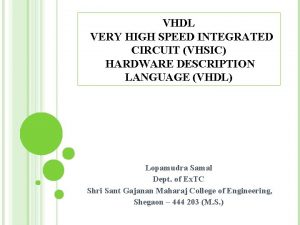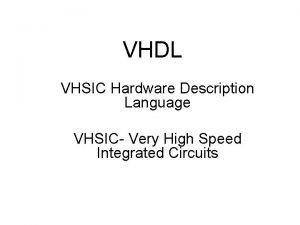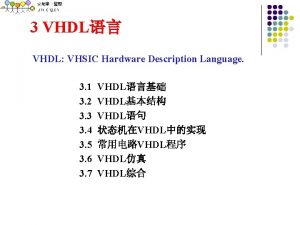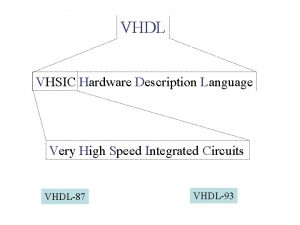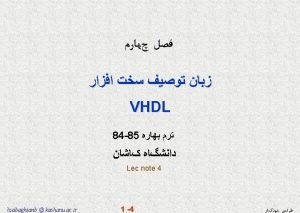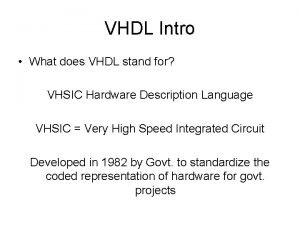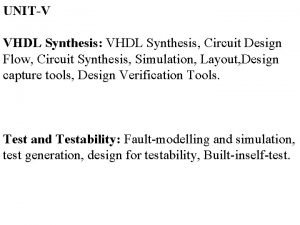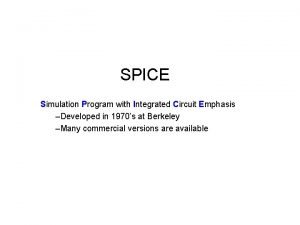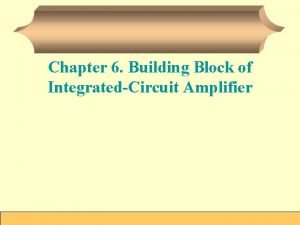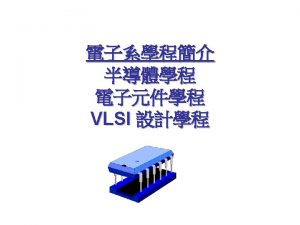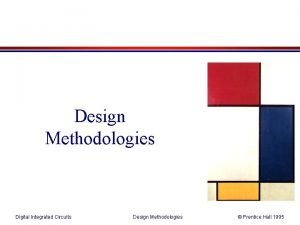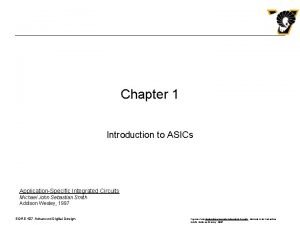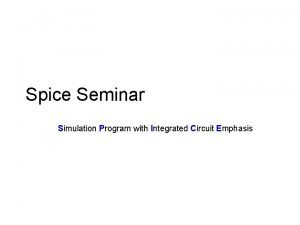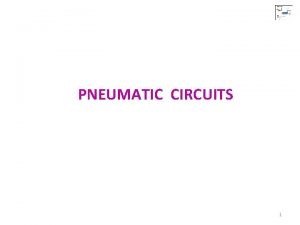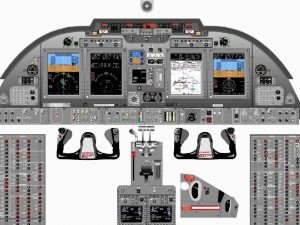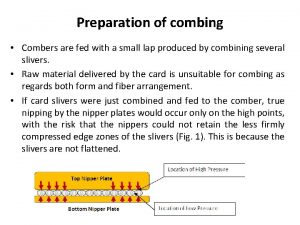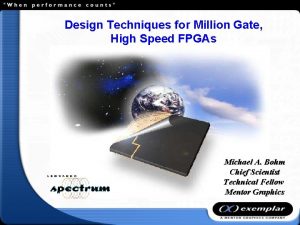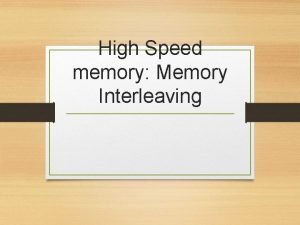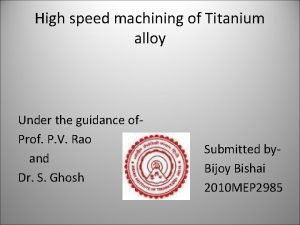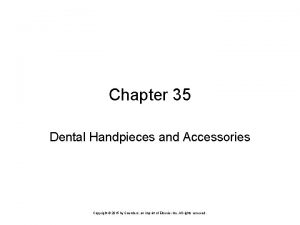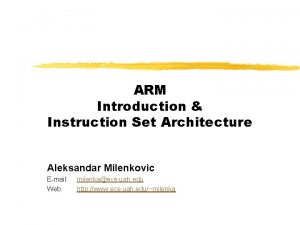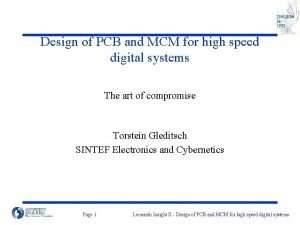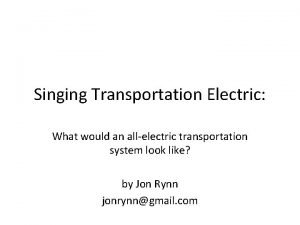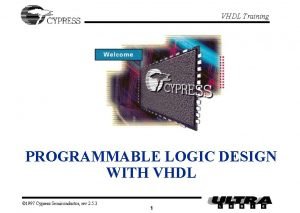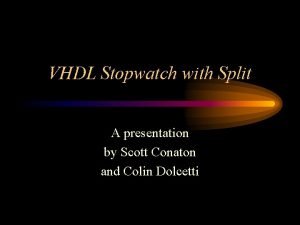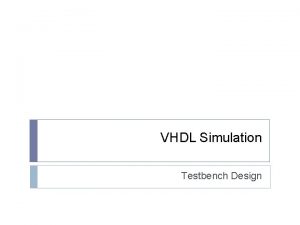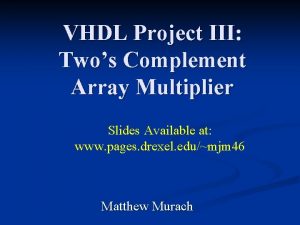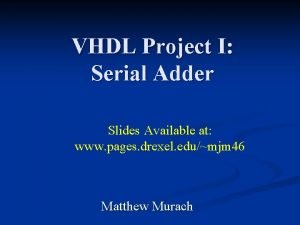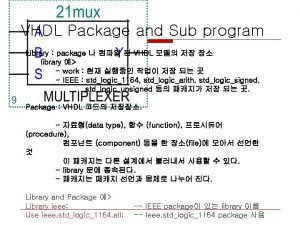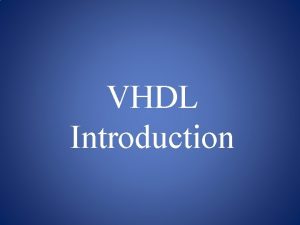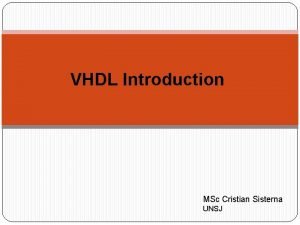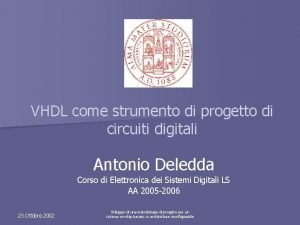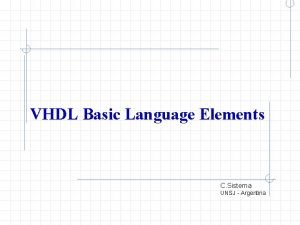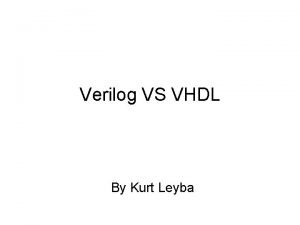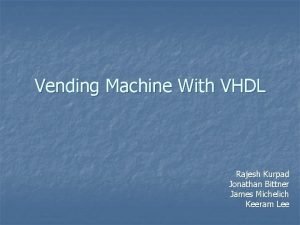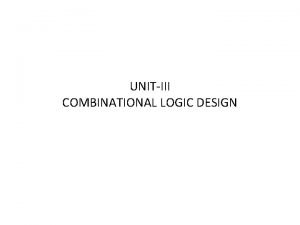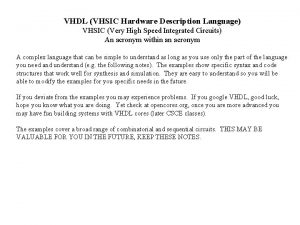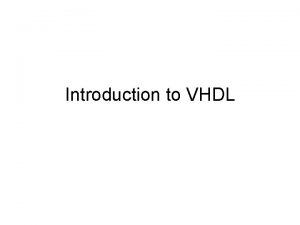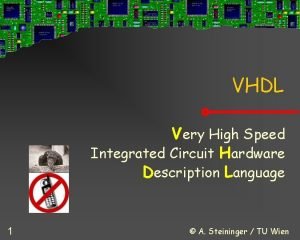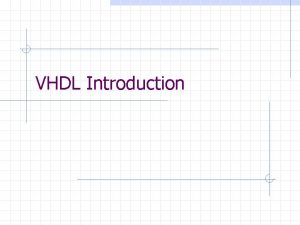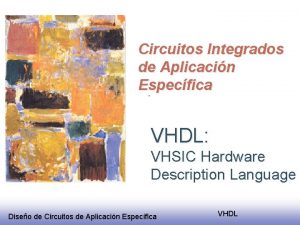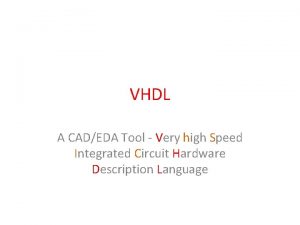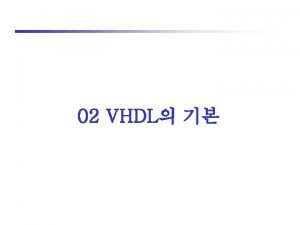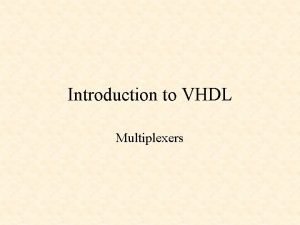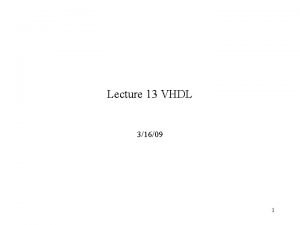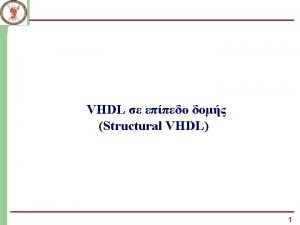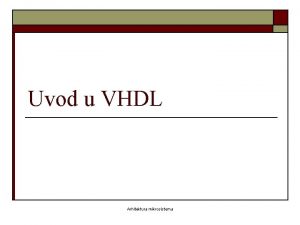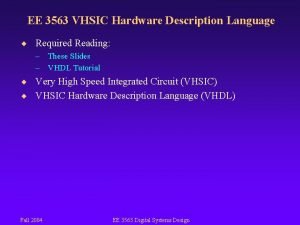VHDL VERY HIGH SPEED INTEGRATED CIRCUIT VHSIC HARDWARE











































































![[ elsif boolean-expression then sequential-statements ] [ else sequential-statements ] end if; -- elsif [ elsif boolean-expression then sequential-statements ] [ else sequential-statements ] end if; -- elsif](https://slidetodoc.com/presentation_image/f3c5c2b374dcc43a1933416559b735da/image-76.jpg)









- Slides: 85

VHDL VERY HIGH SPEED INTEGRATED CIRCUIT (VHSIC) HARDWARE DESCRIPTION LANGUAGE (VHDL) Lopamudra Samal Dept. of Ex. TC Shri Sant Gajanan Maharaj College of Engineering, Shegaon – 444 203 (M. S. )

VHDL’S HISTORY Very High Speed Integrated Circuit (VHSIC) Hardware Description Language (VHDL) is the product of a US Government request for a new means of describing digital hardware. The VHSIC Program was an initiative of the Defence Department to push the state of the art in VLSI technology, and VHDL was proposed as a versatile hardware description language.

VHDL’S HISTORY (CONT. ) The language were first generated in 1981 under the VHSIC program. A number of U. S. companies were involved in designing VHSIC chips for the Department of Defense (Do. D). In July 1983, a team of Intermetrics, IBM and Texas Instruments were awarded a contract to develop VHDL In August 1985, the final version of the language under government contract was released: VHDL Version 7. 2

VHDL’S HISTORY (CONT. ) In December 1987, VHDL became IEEE Standard 1076 - 1987 and in 1988 an ANSI standard In September 1993, VHDL was restandardized to clarify and enhance the language (IEEE Standard 1076 -1993) VHDL has been accepted as a Draft International Standard by the IEC (International Engineering Consortium).


WHY USE AN HDL? Question: How do we know that we have not made a mistake when we manually draw a schematic and connect components to implement a function?

WHY USE AN HDL? Question: How do we know that we have not made a mistake when we manually draw a schematic and connect components to implement a function? Answer: By describing the design in a high-level (easy to understand) language, we can simulate our design before we manufacture it. This allows us to catch design errors, i. e. , that the design does not work as we thought it would. • Simulation guarantees that the design behaves as it should.

REASONS FOR USING VHDL is an international IEEE standard specification language (IEEE 1076 -1993) for describing digital hardware used by industry worldwide VHDL enables hardware modelling from the gate to system level VHDL provides a mechanism for digital design. Testing & Validation using simulation Performance prediction Automatic synthesis The language supports hierarchy, that is, a digital system can be modeled as a set of interconnected components; each component, in turn, can be modeled as a set of interconnected subcomponents.

ADDITIONAL BENEFITS OF VHDL Allows for various design methodologies: top-down, bottom-up. very flexible in its approach to describing hardware. Provides technology independence: VHDL is independent of any technology or process (ASIC, FPGA…) however VHDL code can be written and then targeted for many different technologies. Ability to run the same code in a variety of environment. Provides a flexible design language. It supports both synchronous and asynchronous timing models.

The language supports three basic different description styles: structural, dataflow, and behavioral. A design may also be expressed in any combination of these three descriptive styles. There is no need to learn a different language for simulation control. Test benches can be written using the same language to test other VHDL models.

HARDWARE ABSTRACTION VHDL is used to describe a model for a digital hardware device. This model specifies the external view of the device and one or more internal views. The internal view of the device specifies the functionality or structure, while the external view specifies the interface of the device through which it communicates with the other models in its environment.


The device to device model mapping is strictly a one to many. That is, a hardware device may have many device models. In VHDL, each device model is treated as a distinct representation of a unique device, called an entity in this text. The entity is thus a hardware abstraction of the actual hardware device. Each entity is described using one model that contains one external view and one or more internal views. At the same time, a hardware device may be represented by one or more entities.


BASIC TERMINOLOGY A hardware abstraction of this digital system is called an entity in this text. An entity X, when used in another entity Y, becomes a component for the entity Y. Therefore, a component is also an entity, depending on the level at which you are trying to model. To describe an entity, VHDL provides five different types of primary constructs, called" design units. 1. Entity declaration 2. Architecture body 3. Configuration declaration 4. Package declaration 5. Package body

ENTITY An entity is modeled using an entity declaration and at least one architecture body. The entity declaration describes the external view of the entity, for example, the input and output signal names. The architecture body contains the internal description of the entity. Once an entity has been modeled, it needs to be validated by a VHDL system. A typical VHDL system consists of an analyzer and a simulator. The analyzer reads in one or more design units contained in a single file and compiles them into a design library after validating the syntax and performing some static semantic checks.

The design library is a place in the host environment (that is, the environment that supports the VHDL system) where compiled design units are stored. The simulator simulates an entity, represented by an entity-architecture pair or by a configuration, by reading in its compiled description from the design library and then performing the following steps: 1. Elaboration 2. Initialization 3. Simulation


ENTITY DECLARATION The entity' declaration specifies the name of the entity being modeled and lists the set of interface ports. Ports are signals through which the entity communicates with the other models in its external environment.

ENTITY DECLARATION entity HALF_ADDER is port (A, B: in BIT; SUM, CARRY: out BIT); end HALF_ADDER;

AN ENTITY DECLARATION FOR A 2 -TO 4 DECODER entity DECODER 2 x 4 is port (A, B, ENABLE: in SIT: Z: out BIT_VECTOR(0 to 3)); end DECODER 2 x 4;

ARCHITECTURE BODY The internal details of an entity are specified by an architecture body using any of the following modeling styles: 1. As a set of interconnected components (to represent structure), 2. As a set of concurrent assignment statements (to represent dataflow), 3. As a set of sequential assignment statements (to represent behavior), 4. Any combination of the above three.

CONFIGURATION DECLARATION A configuration declaration is used to select one of the possibly many architecture bodies that an entity may have, and to bind components, used to represent structure in that architecture body, to entities represented by an entity architecture pair or by a configuration, that reside in a design library.

PACKAGE DECLARATION A package declaration is used to store a set of common declarations like components, types, procedures, and functions. These declarations can then be imported into other design units using a context clause.

PACKAGE BODY A package body is primarily used to store the definitions of functions and procedures that were declared in the corresponding package declaration, and also the complete constant declarations for any deferred constants that appear in the package declaration. Therefore, a package body is always associated with a package declaration; furthermore, a package declaration can have at most one package body associated with it.

IDENTIFIERS An identifier in VHDL is composed of a sequence of one or more characters. A legal character is an upper-case letter (A. . . Z), or a lower-case letter (a. . . z), or a digit (0. . . 9) or the underscore ( _ ) character. The first character in an identifier must be a letter and the last character may not be an underscore. Lower-case and upper-case letters are considered to be identical when used in an identifier; as an example. Count, COUNT, and Cou. NT, all refer to the same identifier. Also, -two underscore characters cannot appear consecutively.

Comments in a description must be preceded by two consecutive hyphens (-); the comment extends to the end of the line Examples are — This is a comment; it ends at the end of this line. — To continue a comment onto a second line, a separate — comment line must be started. .

RESERVED WORDS The following identifiers are reserved words in the language (also called keywords), and therefore, cannot be used as identifiers in a VHDL description. Abs access after alias all and architecture array assert attribute begin block body buffer bus case component configuration constant disconnect downto else elsif end entity exit file for function generate generic guarded loop map mod nand new next nor not null of on open or others out package port procedure process range record register rem report return select severity signal subtype then to transport type units until use variable wait when while with xor

DATA OBJECTS A data object holds a value of a specified type. It is created by means of an object declaration. An example is variable COUNT: INTEGER; This results in the creation of a data object called COUNT which can hold integer values. The object COUNT is also declared to be of variable class. Every data object belongs to one of the following three classes: 1. Constant: An object of constant class can hold a single value of a given type. This value is assigned to the object before simulation starts and the value cannot be changed during the course of the simulation.

2. Variable: An object of variable class can also hold a single value of a given type. However in this case, different values can be assigned to the object at different times using a variable assignment statement. 3. Signal: An object belonging to the signal class has a past history of values, a current value, and a set of future values. Future values can be assigned to a signal object using a signal assignment statement. v Signal objects can be regarded as wires in a circuit while variable and constant objects are analogous to their counterparts in a high-level programming language like C or Pascal. Signal objects are typically used to model wires and flip-flops while variable and constant objects are typically used to model the behavior of the circuit.

An object declaration is used to declare an object, its type, and its class, and optionally assign it a value. v Constant Declarations Examples of constant declarations are constant RISE_TIME: TIME : = 10 ns; constant BUS_WIDTH: INTEGER : = 8; v The first declaration declares the object RISE_TIME that can hold a value of type TIME (a predefined type in the language) and the value assigned to the object at the start of simulation is 10 ns. The second constant declaration declares a constant BUS_WIDTH of type INTEGER with a value of 8. An example of another form of constant declaration is constant NO_OF_INPUTS: INTEGER; v The value of the constant has not been specified in this case. Such a constant is called a deferred constant and it can appear only inside a package declaration. The complete constant declaration with the associated value must appear in the corresponding package body. v

Variable Declarations Examples of variable declarations are variable CTRL_STATUS: BIT_VECTOR(10 downto 0); variable SUM: INTEGER range 0 to 100 : = 10; variable FOUND, DONE: BOOLEAN; The first declaration specifies a variable object CTRL_STATUS as an array of II elements, with each array element of type BIT. In the second declaration, an explicit initial value has been assigned to the variable SUM. When simulation starts, SUM will have an initial value of 10. If no initial value is specified for a variable object, a default value is used as an initial value. In the third declaration, the initial values assigned to FOUND and DONE at start of simulation is FALSE (FALSE is the leftmost value of the predefined type, BOOLEAN). The initial value for all the array elements of CTRL_STATUS is '0'.

Signal Declarations Here are some examples of signal declarations. signal CLOCK: BIT; signal DATA_BUS: BIT_VECTOR(0 to 7); signal GATE_DELAY: TIME : = 10 ns; The interpretation for these signal declarations is very similar to that of the variable declarations. The first signal declaration declares the signal object CLOCK of type BIT and gives it an initial value of '0' ('0' being the leftmost value of type BIT). The third signal declaration declares a signal object GATE_DELAY of type TIME that has an initial value of 10 ns.

DATA TYPES Every data object in VHDL can hold a value that belongs to a set of values. This set of values is specified by using a type declaration. A type is a name that has associated with it a set of values and a set of operations. Certain types, and operations that can be performed on objects of these types, are predefined in the language. For example, INTEGER is a predefined type with the set of values being integers in a specific range provided by the VHDL system. The minimum range that must be provided is - (2^31 - 1)= 2147483647 through + (2^31 1)= 2147483647.

Some of the allowable and frequently used predefined operators are +, for addition, -, for subtraction, /, for division, and *, for multiplication. BOOLEAN is another predefined type that has the values FALSE and TRUE, and some of its predefined operators are AND, OR, NAND, AND NOT. The declarations for the predefined types of the language are contained in package STANDARD; the operators for these types are predefined in the language.

The language also provides the facility to define new types by using type declarations and also to define a set of operations on these types by writing functions that return values of this new type. All the possible types that can exist in the language can be categorized into the following four major categories: 1. Scalar types: Values belonging to these types appear in a sequential order. 2. Composite types: These are composed of elements of a single type (an array type) or elements of different types (a record type). 3. Access types: These provide access to objects of a given type (via pointers). 4. File types: These provides access to objects that contain a sequence of values of a given type.

SUBTYPES A subtype is a type with a constraint. The constraint specifies the subset of values for the type. The type is called the base type of the subtype. An object is said to belong to a subtype if it is of the base type and if it satisfies the constraint. Subtype declarations are used to declare subtypes. An object can be declared to either belong to a type or to a subtype. The set of operations belonging to a subtype is the same as that associated with its base type. Subtypes are useful for range checking and for imposing additional constraints on types.

Examples of subtypes are subtype MY_INTEGER is INTEGER range 48 to 156 ; type DIGIT is ('0', '1', '2', '3', '4', '5', '6', '7', '8', '9') ; subtype MIDDLE is DIGIT range '3' to '7' ; In the first example, MY_INTEGER is a subtype of the INTEGER base type and has a range constraint with values ranging from 48 through 156. DIGIT is a userdefined enumeration type. The last subtype declaration declares a new subtype called MIDDLE whose base type is DIGIT and has the values '3', '4', '5', '6' and '7'.

SCALAR TYPES The values belonging to this type are ordered, that is, relational operators can be used on these values. For example, BIT is a scalar type and the expression '0' < ‘ 1' is valid and has value TRUE. There are four different kinds of scalar types. These types are 1. enumeration, 2. integer, 3. physical, 4. floating point.

ENUMERATION TYPES An enumeration type declaration defines a type that has a set of user-defined values consisting of identifiers and character literals. Examples are Type MVL is ('U', '0', '1', 'Z); type MICRO_OP is (LOAD, STORE, ADD, MUL, DIV); SUB, subtype ARITH_OP is MICRO_OP range ADD to DIV;


MVL is an enumeration type that has the set of ordered values, 'U', '0', '1', and 'Z'. ARITH_OP is a subtype of the base type MICRO_OP and has a range constraint specified to be from ADD to DIV, that is, the values ADD, SUB, MUL, and DIV belong to the subtype ARITH_OP.

INTEGER TYPES An integer type defines a type whose set of values fall within a specified integer range. Examples of integer type declarations are type INDEX is range 0 to 15; type WORD_LENGTH is range 31 downto 0; subtype DATA_WORD is WORD_LENGTH range 15 downto 0; type MY_WORD is range 4 to 6;

INDEX is an integer type that includes the integer values from 0 through 15. DATA_WORD is a subtype of WORD_LENGTH that includes the integer values ranging from 15 through 0. The position of each value of an integer type is the value itself. For example, in the type declaration of WORD_LENGTH, value 31 is at position 31, value 14 is at position 14, and so on.

FLOATING POINT TYPES A floating point type has a set of values in a given range of real numbers. Examples of floating point type declarations are type TTL_VOLTAGE is range -5. 5 to -1. 4; type REAL_DATA is range 0. 0 to 31. 9;

Floating point literals can also be expressed in an exponential form. The exponent represents a power of ten and the exponent value must be an integer. Examples are 62. 3 E-2 5. 0 E+2 Integer and floating point literals can also be written in a base other than 10 (decimal). The base can be any value between 2 and 16. Such literals are called based literals. In this case, the exponent represents a power of the specified base. The syntax for a based literal is base # based-value # -- form 1 base # based-value # E exponent -- form 2

Examples are 2#101_000# represents (101101000)2 = (360) in decimal, 16#FA# represents (FA)16= (11111010)2 = (250) in decimal, 16#E#E 1 represents (E)16* (16^1) = 14* 16= (224) in decimal, 2#110. 01 # represents (110. 01)2 = (6. 25) in decimal.

PHYSICAL TYPES A physical type contains values that represent measurement of some physical quantity, like time, length, voltage, and current. Values of this type are expressed as integer multiples of a base unit. An example of a physical type declaration is type CURRENT is range 0 to 1 E 9 units n. A; -- (base unit) nano-ampere u. A = 1000 n. A; -- micro-ampere m. A = 1000 µA; --milli-ampere Amp = 1000 m. A; -- ampere end units; subtype FILTER_CURRENT is CURRENT range 10 µA to 5 m. A;

Values of a physical type are called physical literals. Physical literals are written as an integer literal followed by the unit name. For example, "10 n. A" is a physical literal (note that a space between 10 and n. A is essential) while "Amp" is also a literal that implies I Amp. Other examples are 100 ns 10 V 50 sec Kohm (implies 1 Kohm)

COMPOSITE TYPES A composite type represents a collection of values. There are two composite types: an array type and a record type. An array type represents a collection of values all belonging to a single type; on the other hand, a record type represents a collection of values that may belong to same or different types. An object belonging to a composite type, therefore, represents a collection of subobjects, one for each element of the composite type.

An element of a composite type could have a value belonging to either a scalar type, a composite type, or an access type. For example, a composite type may be defined to represent an array of records.

ARRAY TYPES An object of an array type consists of elements that have the same type. Examples of array type declarations are type ADDRESS_WORD is array (0 to 63) of BIT; type DATA_WORD is array (7 downto 0) of MVL; type ROM is array (0 to 125) of DATA_WORD;

RECORD TYPES An object of a record type is composed of elements of same or different types. It is analogous to the record data type in Pascal and the structure declaration in C. An example of a record type declaration is type PIN_TYPE is range 0 to 10; type MODULE is record SIZE: INTEGER range 20 to 200; CRITICAL_DLY: TIME; NO_INPUTS: PIN_TYPE: NO_OUTPUTS: PIN_TYPE; end record;

type STUDENT_ROLL_NO is range 0 to 10; type STUDENT_NAME is record NO_STUDENT_PASS: INTEGER; NO_STUDENT_FAIL: INTEGER; end record;

ACCESS TYPES Values belonging to an access type are pointers to a dynamically allocated object of some other type. They are similar to pointers in Pascal and C languages. Examples of access type declarations are type PTR is access MODULE; type FIFO is array (0 to 63, 0 to 7) of BIT; type FIFO_PTR is access FIFO; PTR is an access type whose values are addresses that point to objects of type MODULE. Every access type may also have the value null, which means that it does not point to any object. Objects of an access type can only belong to the variable class. When an object of an access type is declared, the default value of this object is null. q

INCOMPLETE TYPES It is possible to have an access type that points to an object that has elements which are also access types. This can lead to mutually dependent or recursive access types. Since a type must be declared before it is used, an incomplete type declaration can be used to solve this problem. An incomplete type declaration has the form type-name; Once an incomplete type has been declared, the typename can now be used in any mutually dependent or recursive access type.

FILE TYPES Objects of file types represent files in the host environment. They provide a mechanism by which a VHDL design communicates with the host environment. The syntax of a file type declaration is type file-type-name Is file of type-name, q The type-name is the type of values contained in the file. Here are two examples. type VECTORS is file of BIT_VECTOR; type NAMES is file of STRING; q A file of type VECTORS has a sequence of values of type BIT_VECTOR; a file of type NAMES has a sequence of strings as values in it.

OPERATORS The predefined operators in the language are classified into the following five categories: 1. Logical operators 2. Relational operators 3. Adding operators 4. Multiplying operators 5. Miscellaneous operators Operators in the same category have the same precedence and evaluation is done left to right. Parentheses may be used to override the left to right evaluation.

LOGICAL OPERATORS The six logical operators are AND OR NAND NOR XOR NOT These operators are defined for the predefined types BIT and BOOLEAN. They are also defined for one dimensional arrays of BIT and BOOLEAN. During evaluation, bit values '0' and 1' are treated as FALSE and TRUE values of the BOOLEAN type, respectively. The result of a logical operation has the same type as its operands. The not operator is a unaiy logical operator and has the same precedence as that of miscellaneous operators.

RELATIONAL OPERATORS These are = /= < <= > >= The result types for all relational operations is always BOOLEAN. The = (equality) and the /= (inequality) operators are permitted on any type except file types. The remaining four relational operators are permitted on any scalar type (e. g. , integer or enumerated types) or discrete array type (i. e. , arrays in which element values belong to a discrete type).

When operands are discrete array types, comparison is performed one element at a time from left to right. For example, BIT_VECTOR'('0', '1') < BIT_VECTOR'('1', '0', '1') is true, since the first element in the first array aggregate is less than the first element in the second aggregate.

ADDING OPERATORS These are + - & The operands for the + (addition) and - (subtraction) operators must be of the same numeric type with the result being of the same numeric type. The addition and subtraction operators may also be used as unary operators, in which case, the operand the result type must be the same. The operands for the & (concatenation) operator can be either a I-Dimensional array type or an element type.

The result is always an array type. For example, '0' & '1’ results in an array of characters "01". 'C' & 'A' & 'T’ results in the value "CAT". "BA" & "LL" creates an array of characters "BALL".

MULTIPLYING OPERATORS These are * / mod rem The * (multiplication) and / (division) operators are predefined for both operands being of the same integer or floating point type. The result is also of the same type. The multiplication operator is also defined for the case when one of the operands is of a physical type and the second operand is of integer or real type. The result is of physical type.

MISCELLANEOUS OPERATORS The miscellaneous operators are abs ** The abs (absolute) operator is defined for any numeric type. The ** (exponentiation) operator is defined for the left operand to be of integer or floating point type and the right operand (i. e. , the exponent) to be of integer type only.

ENTITY DECLARATION An entity declaration describes the external interface of the entity, that is, it gives the black-box view. It specifies the name of the entity, the names of interface ports, their mode (i. e. , direction), and the type of ports. The syntax for an entity declaration is entity-name is [ generic ( list-of-generics-and-theirtypes ) ; ] [ port ( list-of-interface-port-names-andtheir-types) ; ] [ entity-item-declarations ] [ begin entity-statements ] end [ entity-name ];

The entity-name is the name of the entity and the interface ports are the signals through which the entity passes information to and from its external environment. Each interface port can have one of the following modes: 1. in: the value of an input port can only be read within the entity model. 2. out: the value of an output port can only be updated within the entity model; it cannot be read. 3. inout: the value of a bidirectional port can be read and updated within the entity model.

4. buffer: the value of a buffer port can be read and updated within the entity model. However, it differs from the inout mode in that it cannot have more than one source and that the only kind of signal that can be connected to it can be another buffer port or a signal with at most one source.


entity AOI is port (A, B, C, D: in BIT; Z: out BIT); end AOI; The entity declaration specifies that the name of the entity is AOI and that it has four input signals of type BIT and one output signal of type BIT. Note that it does not specify the composition or functionality of the entity.

ARCHITECTURE BODY An architecture body describes the internal view of an entity. It describes the functionality or the structure of the entity. The syntax of an architecture body is architecture-name of entity-name is [ architecture-item-declarations ] begin concurrent-statements; end [ architecture-name ] ;

architecture AOI_CONCURRENT of AOI is begin Z <= not ( (A and B) or (C and D) ); end AOI_CONCURRENT; architecture AOI_SEQUENTIAL of AOI is begin process (A, B, C, D) variable TEMPI , TEMP 2: BIT; begin TEMP 1 : = A and B; -- statement 1 TEMP 2: =C and D; --statement 2 TEMP 1 : = TEMP 1 or TEMP 2; -- statement 3 Z<= not TEMP 1; --statement 4 end process; end AOI_SEQUENTIAL;

The first architecture body, AOI_CONCURRENT, describes the AOI entity using the dataflow style of modeling. The second architecture body, AOI_SEQUENTIAL, uses the behavioral style of modeling.

PROCESS STATEMENT A process statement contains sequential statements that describe the functionality of a portion of an entity in sequential terms. The syntax of a process statement is [ process-label: ] process [ ( sensitivity-list ) ] [process-item-declarations] begin sequential-statements; end process [ process-label];

IF STATEMENT An if statement selects a sequence of statements for execution based on the value of a condition. The condition can be any expression that evaluates to a Boolean value. The general form of an if statement is if boolean-expression then sequential-statements
![elsif booleanexpression then sequentialstatements else sequentialstatements end if elsif [ elsif boolean-expression then sequential-statements ] [ else sequential-statements ] end if; -- elsif](https://slidetodoc.com/presentation_image/f3c5c2b374dcc43a1933416559b735da/image-76.jpg)
[ elsif boolean-expression then sequential-statements ] [ else sequential-statements ] end if; -- elsif clause; if stmt can have 0 or -- more elsif clauses. -- else clause.

if SUM <= 100 then -- This is a less-than-orequal-to operator. SUM : = SUM+10; end if;

CASE STATEMENT The format of a case statement is case expression is when choices => sequential-statements -- branch #1 when choices => sequential-statements --branch #2 Can have any number of branches. [ when others => sequential-statements ] -- last branch end case;

An example of a case statement is type WEEK_DAY is (MON, TUE, WED, THU, FRI, SAT, SUN); type DOLLARS is range 0 to 10; variable DAY: WEEK_DAY; variable POCKET_MONEY: DOLLARS; case DAY is when TUE => POCKET_MONEY : = 6; --branch 1 when MON I WED => POCKET_MONEY : = 2; -- branch 2 when FRI to SUN => POCKET_MONEY : = 7; -- branch 3 when others => POCKET_MONEY : = 0; -- branch 4 end case;

NULL STATEMENT The statement null; is a sequential statement that does not cause any action to take place and execution continues with the next statement. One example of this statement's use is in an if statement or in a case statement where for certain conditions, it may be useful or necessary to explicitly specify that no action needs to be performed.

LOOP STATEMENT A loop statement is used to iterate through a set of sequential statements. The syntax of a loop statement is [ loop-label : ] iteration-scheme loop sequential-statements end loop [ loop-label ] ; There are three types of iteration schemes. The first is the for iteration scheme that has the form for identifier in range

There are three types of iteration schemes. The first is the for iteration scheme that has the form for identifier in range An example of this iteration scheme is FACTORIAL : = 1; for NUMBER in 2 to N loop FACTORIAL : = FACTORIAL * NUMBER; end loop;

The second form of the iteration scheme is the while scheme that has the form while boolean-expression An example of the while iteration scheme is J: =0; SUM: =10; WH-LOOP: while J < 20 loop - This loop has a label, WH_LOOP. SUM : = SUM * 2; J: =J+3; end loop;

The third and final form of the iteration scheme is one where no iteration scheme is specified. In this form of loop statement, all statements in the loop body are repeatedly executed until some other action causes it to exit the loop. These actions can be caused by an exit statement, a next statement, or a return statement. Here is an example SUM: =1; J: =0; L 2: loop J: =J+21; SUM : = SUM* 10; exit when SUM > 100; end loop L 2;

EXIT STATEMENT The exit statement is a sequential statement that can be used only inside a loop. It causes execution to jump out of the innermost loop or the loop whose label is specified. The syntax for an exit statement is exit [ loop-label] [ when condition ]:
 Very high speed integrated circuit
Very high speed integrated circuit Vhsic hardware description language
Vhsic hardware description language Language
Language Vhsic hardware description language
Vhsic hardware description language One effect of high-speed driving is speed smear in which
One effect of high-speed driving is speed smear in which What is hdl hardware description language
What is hdl hardware description language Hdl is
Hdl is Vhdl stands for
Vhdl stands for Vhdl design flow
Vhdl design flow External computer hardware
External computer hardware Very bad to very good scale
Very bad to very good scale Scientific notation rules
Scientific notation rules There is very few soup in the bowl
There is very few soup in the bowl It is a very shallow skillet with very short sloping sides
It is a very shallow skillet with very short sloping sides Very little food
Very little food Bowling ball vs ping pong ball
Bowling ball vs ping pong ball Find speed
Find speed Speed detection of moving vehicle
Speed detection of moving vehicle Simulation program with integrated circuit emphasis
Simulation program with integrated circuit emphasis Ssi msi lsi vlsi ulsi classification
Ssi msi lsi vlsi ulsi classification Building blocks of integrated-circuit amplifiers中文
Building blocks of integrated-circuit amplifiers中文 Gambar dioda
Gambar dioda Msi lsi vlsi ulsi
Msi lsi vlsi ulsi Integrated circuit
Integrated circuit Gate array based asic
Gate array based asic Readout integrated circuit
Readout integrated circuit Shanghai integrated circuit industry
Shanghai integrated circuit industry Simulation program with integrated circuit emphasis
Simulation program with integrated circuit emphasis Ic integrated circuit pertama kali ditemukan pada
Ic integrated circuit pertama kali ditemukan pada Simple pneumatic circuit
Simple pneumatic circuit Low mass star life cycle
Low mass star life cycle Which rock possesses very high compressive strength?
Which rock possesses very high compressive strength? Vor service volumes
Vor service volumes Bread and roses integrated arts high school
Bread and roses integrated arts high school Current in parallel vs series
Current in parallel vs series Types of circuit
Types of circuit Parallel circuit circuit construction kit
Parallel circuit circuit construction kit Series vs parallel current
Series vs parallel current What is incomplete circuit
What is incomplete circuit Short circuit example
Short circuit example Venn diagram of climate and weather
Venn diagram of climate and weather Blood circulation system diagram
Blood circulation system diagram Advantages of parallel circuit over series circuit
Advantages of parallel circuit over series circuit High speed combers
High speed combers Nergeco door installation
Nergeco door installation High speed lans
High speed lans Horse latitude
Horse latitude Ti high speed adc
Ti high speed adc High speed design techniques
High speed design techniques High speed traffic management
High speed traffic management Acn home phone
Acn home phone Interleaved memory organization
Interleaved memory organization High speed machining titanium
High speed machining titanium Dental handpieces and accessories chapter 35
Dental handpieces and accessories chapter 35 Arm instruction set architecture
Arm instruction set architecture Acn internet pei
Acn internet pei Midwest high speed rail association
Midwest high speed rail association High speed pcb layout techniques
High speed pcb layout techniques High speed wireless lan
High speed wireless lan City-region
City-region Pcb material selection
Pcb material selection Oslo to stockholm high speed train
Oslo to stockholm high speed train High speed networks
High speed networks Semi high speed
Semi high speed Ion pumps in the pumping speed range 150 to 1000 l/s
Ion pumps in the pumping speed range 150 to 1000 l/s Pcb high speed
Pcb high speed High speed chapter 7
High speed chapter 7 High speed machining definition
High speed machining definition Salishan conference on high speed computing
Salishan conference on high speed computing Narrow belts of high speed winds
Narrow belts of high speed winds Acninc com
Acninc com Vhdl xilinx
Vhdl xilinx Vhdl clock
Vhdl clock Colin dolcetti
Colin dolcetti Vhdl modulo
Vhdl modulo Vhdl 2's complement
Vhdl 2's complement Vhdl code for serial adder
Vhdl code for serial adder Vhdl generic문
Vhdl generic문 Disadvantages of vhdl
Disadvantages of vhdl Vhdl
Vhdl Vhdl hierarchy
Vhdl hierarchy Corso vhdl
Corso vhdl Vhdl array attributes
Vhdl array attributes Verilog vs vhdl
Verilog vs vhdl Bittner vending
Bittner vending 74x139 decoder
74x139 decoder
